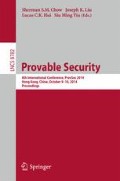Abstract
In FSE’10, Nandi proved a sufficient condition of pseudo random function (PRF) for affine domain extensions (ADE), a wide class of blockcipher based domain extensions. This sufficient condition is satisfied by all known ADE, however, it is not a characterization of PRF. In this paper we completely characterize the ADE and show that weaker security notions message authentication code (MAC) and weakly collision resistant (WCR) are indeed equivalent to PRF.
Access this chapter
Tax calculation will be finalised at checkout
Purchases are for personal use only
Preview
Unable to display preview. Download preview PDF.
References
Bellare, M.: New Proofs for NMAC and HMAC: Security Without Collision-Resistance. In: Dwork, C. (ed.) CRYPTO 2006. LNCS, vol. 4117, pp. 602–619. Springer, Heidelberg (2006). Citations in this document: §1.
Bellare, M., Guérin, R., Rogaway, P.: XOR MACs: New Methods for Message Authentication Using Finite Pseudorandom Functions. In: Coppersmith, D. (ed.) CRYPTO 1995. LNCS, vol. 963, pp. 15–28. Springer, Heidelberg (1995)
Bellare, M., Pietrzak, K., Rogaway, P.: Improved Security Analyses for CBC MACs. In: Shoup, V. (ed.) CRYPTO 2005. LNCS, vol. 3621, pp. 527–545. Springer, Heidelberg (2005)
Bellare, M., Kilian, J., Rogaway, P.: The security of cipher block chaining. In: Desmedt, Y.G. (ed.) CRYPTO 1994. LNCS, vol. 839, pp. 341–358. Springer, Heidelberg (1994)
Bernstein, D.J.: A short proof of the unpredictability of cipher block chaining (2005), http://cr.yp.to/papers.html#easycbc
Black, J.A., Rogaway, P.: CBC MACs for arbitrary-length messages: The three-key constructions. In: Bellare, M. (ed.) CRYPTO 2000. LNCS, vol. 1880, p. 197. Springer, Heidelberg (2000). Citations in this document: §1.1.
Datta, N., Nandi, M.: Equivalence between MAC and PRF for Blockcipher based Constructions, ePrint Archive, 2013/575 (2013). Citations in this document: §2.
Black, J.A., Rogaway, P.: A Block-Cipher Mode of Operations for Parallelizable Message Authentication. In: Knudsen, L.R. (ed.) EUROCRYPT 2002. LNCS, vol. 2332, pp. 384–397. Springer, Heidelberg (2002). Citations in this document: §1.1.
Goldreich, O., Goldwasser, S., Micali, S.: How to construct random functions. JACM, 792–807 (1986). Citations in this document: §1.
Iwata, T., Kurosawa, K.: OMAC: One-Key CBC MAC. In: Johansson, T. (ed.) FSE 2003. LNCS, vol. 2887, pp. 129–153. Springer, Heidelberg (2003). Citations in this document: S1.1.
Iwata, T., Kurosawa, K.: Stronger Security Bounds for OMAC, TMAC, and XCBC. In: Johansson, T., Maitra, S. (eds.) INDOCRYPT 2003. LNCS, vol. 2904, pp. 402–415. Springer, Heidelberg (2003)
Jutla, C.S.: PRF Domain Extension using DAG. In: Halevi, S., Rabin, T. (eds.) TCC 2006. LNCS, vol. 3876, pp. 561–580. Springer, Heidelberg (2006)
Luby, M., Racko, C.: How to construct pseudorandom permutations from pseudorandom functions. SIAM Journal of Computing, 373–386 (1988). Citations in this document: §1.1.
Minematsu, K., Matsushima, T.: New Bounds for PMAC, TMAC, and XCBC. In: Biryukov, A. (ed.) FSE 2007. LNCS, vol. 4593, pp. 434–451. Springer, Heidelberg (2007)
Mandal, A., Nandi, M.: Improved Security Analysis of PMAC. Journal of Mathematical Cryptology, 149–162 (July 2008)
Nandi, M.: A Unified Method for Improving PRF Bounds for a Class of Blockcipher Based MACs. In: Hong, S., Iwata, T. (eds.) FSE 2010. LNCS, vol. 6147, pp. 212–229. Springer, Heidelberg (2010). Citations in this document: §1.1, §1.2.
Nandi, M.: Improved security analysis for OMAC as a pseudorandom function. Journal of Mathematical Cryptology, 133–148 (2009)
Nandi, M.: Fast and Secure CBC-Type MAC Algorithms. In: Dunkelman, O. (ed.) FSE 2009. LNCS, vol. 5665, pp. 375–393. Springer, Heidelberg (2009). Citations in this document: §1.1.
Nandi, M.: A Simple and Unified Method of Proving Indistinguishability. In: Barua, R., Lange, T. (eds.) INDOCRYPT 2006. LNCS, vol. 4329, pp. 317–334. Springer, Heidelberg (2006)
Patarin, J.: Etude des Générateurs de Permutations Basés sur le Schéma du D.E.S., Phd Thésis de Doctorat de l’Université de Paris 6 (1991)
Petrank, E., Racko, C.: CBC MAC for real-time data sources. Journal of Cryptology 13, 315–338 (2000)
Pietrzak, K.: A Tight Bound for EMAC. In: Bugliesi, M., Preneel, B., Sassone, V., Wegener, I. (eds.) ICALP 2006. LNCS, vol. 4052, pp. 168–179. Springer, Heidelberg (2006)
Sarkar, P.: Pseudo-Random Functions and Parallelizable Modes of Operations of a Block Cipher (2009), http://eprint.iacr.org/2009/217
Vaudenay, S.: Decorrelation over infinite domains: The encrypted CBC-MAC case. In: Stinson, D.R., Tavares, S. (eds.) SAC 2000. LNCS, vol. 2012, pp. 189–201. Springer, Heidelberg (2001)
Author information
Authors and Affiliations
Editor information
Editors and Affiliations
Rights and permissions
Copyright information
© 2014 Springer International Publishing Switzerland
About this paper
Cite this paper
Datta, N., Nandi, M. (2014). Equivalence between MAC, WCR and PRF for Blockcipher Based Constructions. In: Chow, S.S.M., Liu, J.K., Hui, L.C.K., Yiu, S.M. (eds) Provable Security. ProvSec 2014. Lecture Notes in Computer Science, vol 8782. Springer, Cham. https://doi.org/10.1007/978-3-319-12475-9_21
Download citation
DOI: https://doi.org/10.1007/978-3-319-12475-9_21
Publisher Name: Springer, Cham
Print ISBN: 978-3-319-12474-2
Online ISBN: 978-3-319-12475-9
eBook Packages: Computer ScienceComputer Science (R0)

